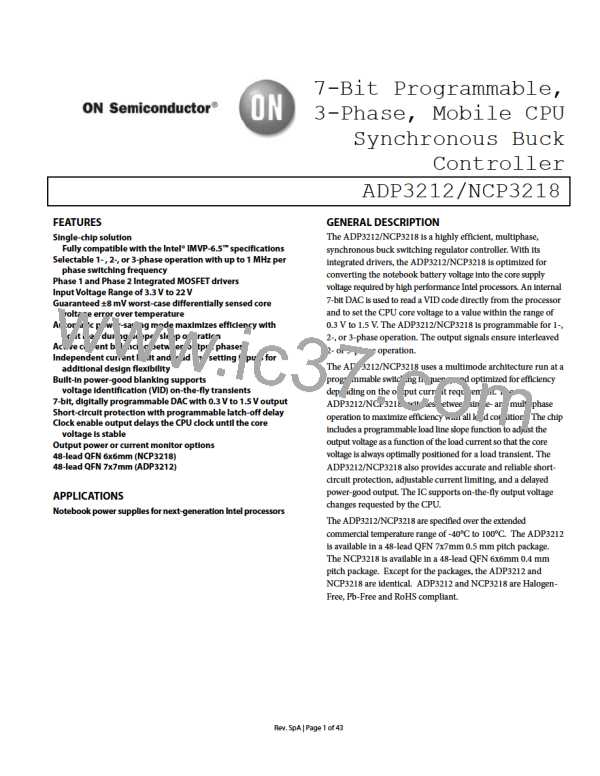ADP3212/NCP3218
3. Find the relative value of RCS required for each of the two
temperatures. The relative value of RCS is based on the
percentage of change needed, which is initially assumed to
be 0.39%/°C in this example.
The relative values are called r1 (r1 is 1/(1+ TC × (T1 − 25)))
and r2 (r2 is 1/(1 + TC × (T2 − 25))), where TC is 0.0039,
T1 is 50°C, and T2 is 90°C.
4. Compute the relative values for rCS1, rCS2, and rTH by using
the following equations:
Figure 22. Temperature-Compensation Circuit Values
(A − B)× r1 × r2 − A ×(1 − B)× r2 + B ×(1 − A)× r1
rCS2
rCS1
=
=
(8)
The following procedure and expressions yield values for
A ×(1 − B)× r1 − B ×(1 − A)× r2 − (A − B)
RCS1, RCS2, and RTH (the thermistor value at 25°C) for a given
(1 − A)
RCS value.
1
A
−
1. Select an NTC to be used based on its type and value.
Because the value needed is not yet determined, start with
a thermistor with a value close to RCS and an NTC with an
initial tolerance of better than 5%.
2. Find the relative resistance value of the NTC at two
temperatures. The appropriate temperatures will depend
on the type of NTC, but 50°C and 90°C have been shown
to work well for most types of NTCs. The resistance values
are called A (A is RTH(50°C)/RTH(25°C)) and B (B is
RTH(90°C)/RTH(25°C)). Note that the relative value of the
NTC is always 1 at 25°C.
1 − rCS2 r1 − rCS2
1
rTH
=
1
1
−
1−rCS2 rCS1
5. Calculate RTH = rTH × RCS, and then select a thermistor of
the closest value available. In addition, compute a scaling
factor k based on the ratio of the actual thermistor value
used relative to the computed one:
RTH(ACTUAL)
k =
(9)
RTH(CALCULATED)
6. Calculate values for RCS1 and RCS2 by using the following
equations:
RCS1 = RCS ×k×rCS1
(10)
RCS2 = RCS ×((1−k)+(k×rCS2 ))
For example, if a thermistor value of 100 kΩ is selected in Step 1,
an available 0603-size thermistor with a value close to RCS is the
Vishay NTHS0603N04 NTC thermistor, which has resistance
values of A = 0.3359 and B = 0.0771. Using the equations in
Step 4, rCS1 is 0.359, rCS2 is 0.729, and rTH is 1.094. Solving for rTH
yields 241 kΩ, so a thermistor of 220 kΩ would be a reasonable
selection, making k equal to 0.913. Finally, RCS1 and RCS2 are found
to be 72.1 kΩ and 166 kΩ. Choosing the closest 1% resistor for
RCS2 yields 165 kΩ. To correct for this approximation, 73.3 kΩ
is used for RCS1
.
Rev. SpA | Page 30 of 43

 ONSEMI [ ONSEMI ]
ONSEMI [ ONSEMI ]